

Prudhoe Bay is the largest oilfield in North America, measuring approximately 15 miles by 40 miles. It is located in northern Alaska on the coast of the Arctic Ocean. The main Prudhoe Bay field has a number of adjacent 'satellite' oilfields, some of which are Kuparuk ("Kuh-PARR-uck"), Endicott, Point MacIntyre, Milne Point, and Niakuk ("NY-uh-kuck".)The two major oil producers in Prudhoe Bay are BP (British Petroleum) and Phillips (formerly ARCO). In addition, there are about five other oil companies with a financial interest. Prudhoe Bay and its associated fields produce nearly 1 million barrels (42 million gallons) per day. The area has produced approximately 15 billion barrels (630 billion gallons) of crude oil in its 25-year history, or nearly one-fifth of U.S. consumption.
I'm Gary Hoefs, a student at the University of Minnesota Duluth. I worked in Prudhoe Bay for two years before returning to college. Since most people will never have the chance to visit this amazing place, I'll do my best to describe it for you as I remember it.


